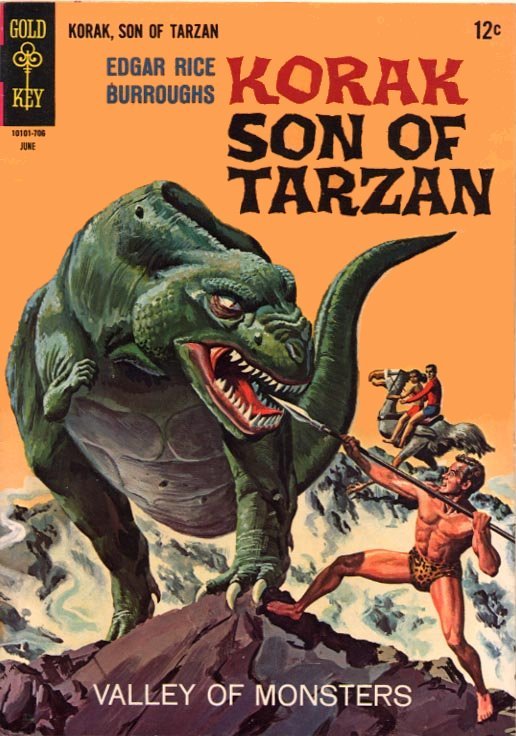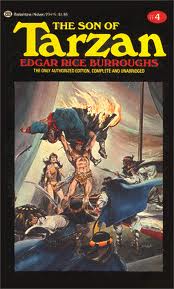The Great Tarzan Adventure #8: Tarzan the Terrible
 Sunday, September 28, 2014 at 05:40PM
Sunday, September 28, 2014 at 05:40PM Let me say up front that Tarzan the Terrible has earned top ranking as my favorite of the series. Yep, one finally beat out Beasts. It has everything I love going for it: a lost world yarn, an undiscovered civilization, and dinosaurs! This book reads like Burroughs’ imagination unleashed. (Perhaps that would have been a better name for it!) While he is referred to as “the Terrible” throughout the book, to me, this is the first time he has truly acted like a Lord of the Jungle. Tarzan has dropped his cruel streak finally, and we see him acting out of love and fear for Jane, who was abducted in the previous volume. But we also get to see Tarzan fighting for a sense of what’s right.
Oh, and then there was another thing I loved about this book, but first I have to say – *SPOLERS!*
Here’s what I liked:
 Pal-ul-don: I really enjoyed this lost world. Burroughs described it superbly, with its vast swamped-surrounded jungle, cliff dweller lodgings, and the fabulous walled city. This is the lost world tale I’ve been waiting for. Everything is eerily familiar yet strangely different. I hope to see more of it in future volumes.
Pal-ul-don: I really enjoyed this lost world. Burroughs described it superbly, with its vast swamped-surrounded jungle, cliff dweller lodgings, and the fabulous walled city. This is the lost world tale I’ve been waiting for. Everything is eerily familiar yet strangely different. I hope to see more of it in future volumes. - The Waz-don and the Ho-don: Theses tribes are the perfect inhabitants for a lost world. I was very surprised, too, when this “sub-human” folk with their monkey-tails, hands and feet turned out to be quite the opposite. I don’t know that there’s anything beyond one being white and hairless and the other covered with black fur. I’m sure someone has read something into it. (And the fact that the whites lived in the city while the blacks lived in the cliff-dwellings.) I simply enjoyed the experience. Both were equally intelligent and both had their good and bad traits. Only in appearance did they differ from the “outside” world. And tech level, of course.
- Dinosaurs: Okay, so this was a big selling point for me from the cover. I wanted a lost valley with dinosaurs. Well, they were there – things called Gryfs. These were actually omnivorous triceratops, which was okay, but then there were some kind of giant ape-men who could control them with sticks. Sort of took the thunder out of them, but they were cool nonetheless.
- Korak: The Killer returns! I was so glad to see him again. Even though he did not officially appear until the end of the book, we have glimpses of a mysterious tracker throughout the story. I knew it was Korak all along, but it was thrilling to be verified. Maybe we’ll get to see more of him in the next book (see last paragraph below).
Were there things I didn’t like? Sure. The story definitely moved at the pace of plot convenience at times. Jane was lost, not only in Africa, but in a lost world in Africa. She’s found in less than two hundred fifty pages. Not complaining too much since any writer today probably would have done it in three 1000 page volumes at the least. When Tarzan finds her, takes her away, she’s captured again pretty easily. Tarzan always meets who he needs to or who can best help him, too. Again, a minor complaint compared to the sense of wonder Burroughs creates.
Yep, I really, really liked this one. Terrible actually read like a fantasy novel. It was filled with vivid scenes and images, and we have a hero that acts truly heroic. While the conflict is pretty black and white, it does not diminish the story one bit. If anything, it highlights the archetypal nature of Tarzan.
Next up is volume 9, Tarzan and the Golden Lion. I glimpsed over Wikipedia, which stated that this one caps off the story that began in Untamed. Maybe I just became so enthralled with the thrill ride, but I felt this one ended quite nicely. Anyway, hope to see you there!





